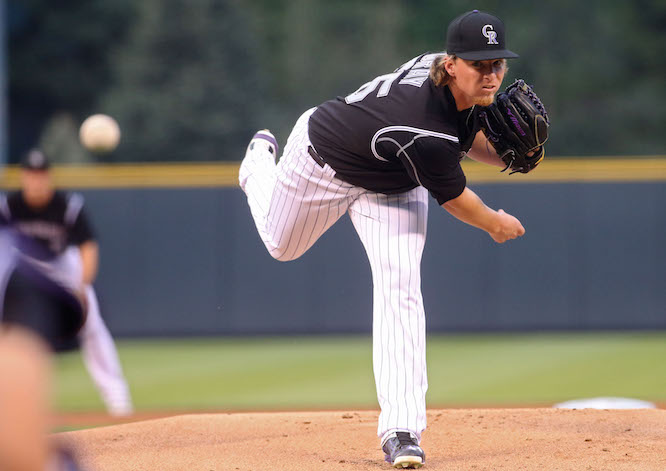If the Colorado Rockies want their pitchers to be successful at Coors Field, they need to do something to shake the team’s very foundation. They need an injection into the bedrock that can spring forth a better outcome than they’ve experienced over the past five-plus years.
They need some fracking gas.
Playing in a cavernous ballpark with baseballs that have to be artificially humidified to try and keep them in the yard, the longstanding belief has been that the Rockies need ground ball pitchers to win. Think Aaron Cook. The notion seems logical – don’t let the ball get up into the thin Mile High air where it can leave the park or find the gap. And Cook was the model for success, having held the franchise mark in career victories until this season when he was passed by Jorge De La Rosa.
But the ground ball pitcher philosophy has burned the Rockies over the past five years. In that time, Colorado has marched out the likes of Kyle Kendrick (2015), Brett Anderson (2014), Jon Garland (2013), Jeremy Guthrie (2012) and Cook (2011) – all expected to be front-of-the-rotation guys who relied on their sinker to get ground ball outs.
In those five years, those five pitchers combined for and 18-41 record. Only Anderson (1-3), who started just eight games for the Rockies in an injury-riddled season, had an ERA below 5.75. Three of the five had ERAs over 6.00 in their respective year with Colorado.
It’s time to replace the ground ball pitcher with someone who can bring the gas.
Back in 2011, the Houston Astros finished with 106 losses, good for the worst record in baseball by a long shot. The Kansas City Royals were 71-91, fourth in the AL, a full 24 games behind the Tigers. The New York Mets were 77-85, 25 games behind the Phillies in the NL East. The Rockies were 73-89 that year, fourth in the NL West.
Three of those teams are in the playoffs this year. You’re reading a column about the pitching woes of the one that is not.
So what’s the big difference between the Rockies and those three teams that are currently chasing a pennant?
According to the velocity charts on FanGraphs.com, each of those three clubs has at least two qualified starting pitchers who rank in the top 70 in Major League baseball in average fastball velocity in 2015. The Royals and Mets claim the Nos. 1 and 2 spots on that list with Yordano Ventura and Matt Harvey. New York follows with Jacob deGrom, who comes in at No. 7 on that list. (Open it up to guys with at least 100 IP and they can add Noah Syndergaard at the top of the list.)
In fact, on the top-10 list of MLB’s hardest throwing qualified starters, seven saw their clubs make the postseason this year. The Cardinals, a model franchise by any account, has two of their own in the top-20.
The Rockies did not have a single qualified starter who cracked the list (which included 78 pitchers).
If Colorado is going to compete in the highly competitive NL West with teams like the Dodgers and Giants, teams with top-of-the-rotation guys like Zack Greinke, Clayton Kershaw, Madison Bumgarner and Matt Cain, they’re not going to do it with pitchers like Kendrick, Anderson, Garland and Guthrie at the front of the rotation.
Jorge De La Rosa has somehow mastered pitching at Coors Field without overpowering velocity, but he’s been the exception to the rule (and has decent velocity for a lefty). Sure, there’s the De La Rosa and Jeff Francis types that throw off the curve, but some of Colorado’s most successful pitchers have had live arms – Ubaldo Jimenez, Jhoulys Chacin, Pedro Astacio. Colorado needs more like them and less like Kendrick.
Jon Gray and Eddie Butler appear to have those kinds of arms. So does Jeff Hoffman and Jesus Tinoco (both acquired in the Troy Tulowitzki trade). If Colorado hopes to succeed in 2016 (okay, 2017) and beyond, they need those arms to develop into legitimate Major League pitchers, not just Major League talent. And they need to find a free agent or two who’s just bold and brazen enough to believe that his stuff is good enough (and hard enough) to succeed at altitude.
If they don’t, the only “gas” we’ll be talking about is the kind we’re pouring on the fire that has been the Rockies rotation for the past five years.
